Originally posted 2019-02-15 05:23:22.
Gradient Factor Comparison: 60m Trimix Case-Study
As a follow-up to my previous article, ‘A Logical Application of Gradient Factors Settings for Open-Circuit Tech Divers‘, I have decided to write a comparative case study that illustrates the effect that three different gradient factor settings can have on the dynamics of the dive.
Disclaimer: Any opinions provided in this article only reflect my own successful approach to decompression using gradient factors. Dives requiring staged decompression are substantially more risky than dives that stay well within no-stop limits. No strategy can guarantee to protect every diver from DCS injury. Consequently, I reserve liability for any decisions you may make. Never risk your life on only one source of information. If you choose to make riskier dives, obtain the proper training and work up to them slowly to gain experience.
For this case study, I have used Multideco software running ZHL-16C to plan an open-circuit 18/45 trimix dive to a depth of 60m for 20 minutes. The dive utilised a single deco mix of 50%, with a gas switch conducted at the MOD of 21m.
Three gradient factors for comparison
We shall compare three profiles for this dive, based on the following gradient factors:
- Profile 1 – Gradient Factor 30/85 (Shearwater default)
- Profile 2 – Gradient Factor 55/85 (moderate setting)
- Profile 3 – Gradient Factor 70/85 (first stop at gas switch depth)
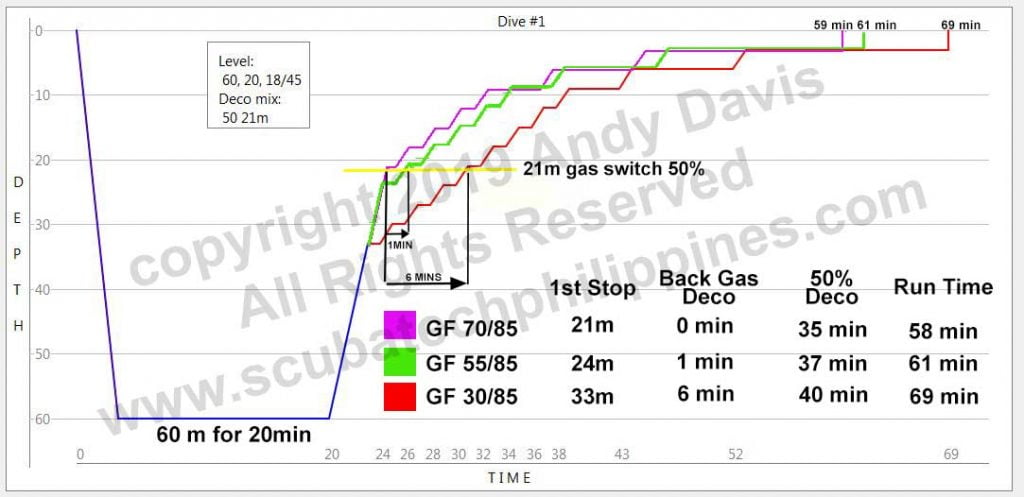
A quick analysis of the profiles shows that the 30/85 profile mandates 6 minutes of back-gas decompression (from 33m) before the deco gas switch. This, in turn, necessitates a further 5 minutes of accelerated decompression to resolve the additional slow tissue inert-gas loading that has occurred.
The 55/85 profile only demands a 1-minute stop below switch depth (at 24m). This results in 2 extra minutes of accelerated decompression to resolve the additional slow tissue inert-gas loading that has occurred.
The 70/85 profile causes no decompression below the 50% gas switch. Because slow tissue inert-gas loading has been minimized, it provides the shortest overall run-time, as the accelerated decompression is only 35 minutes in duration.
If I choose the GFlo 70 option, I would add conservatism by lowering the GFhi to give a comparable amount of total decompression time to the 30/85 profile.
A profile of 70/70 gives a 67-minute run-time, all of which is accelerated deco. Thus, you will surface at a much lower tissue tension and release much more inert gas.
Supersaturation Factors – Differential and Micro-Emboli
The inherent issue with elevating the GFlo to provoke the first decompression stop at the gas switch (21m) is that the inert-gas super-saturation gradient raises much higher than if you stopped at a deeper depth (33m or 24m).
This is illustrated in the graph below:
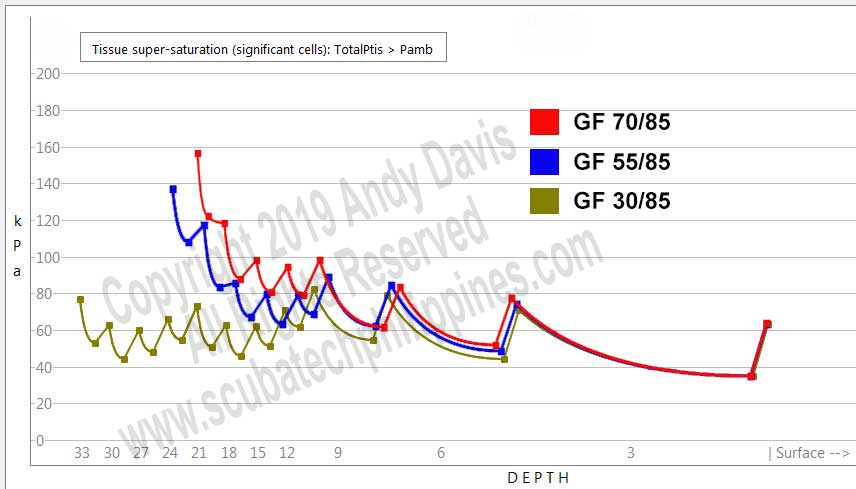
From the graph, we can see that, regardless of profile, the inert-gas differential becomes very comparable by the time you’ve reached 9m depth. It is equal by the start of the 6m stop.
There is obviously more strain on the fast-tissue compartments with a 70/85 profile. As a comparative reference, an 18m/min ascent from 30m (PADI RDP standard) would provoke a maximum super-saturation gradient of circa 140 kPa before surfacing.
High Super-Saturation and Micro-Emboli
Higher super-saturation gradients can be predicted to stimulate more micro-emboli formation. However, we anticipate that fast-tissue micro-emboli resolve very swiftly – especially when using helium and switching to a non-helium mixture (i.e. 50%).
The major factors associated with short lifespan fast-tissue micro-emboli are that they can stimulate the complement system (immune response); whereby histamine and serotonin might cause post-dive fatigue. Even once the micro-emboli are long resolved, the complement system will nonetheless have to continue its usual cycle until completion.
Can We Avoid The Decompression Stress?
There is some reason to believe that triggering the complement system requires micro-emboli to exist for a pre-defined period of time. This could be several minutes.
In the profile given, the high super-saturation only exists for about 90 seconds before the gas switch.
We know that bubbles take some time to form, even at very high tissue super-saturations – just consider the 5-minute ‘window’ used by commercial and military divers doing surface deco. Surface decompression involves a rapid ascent from depth followed by a very quick transfer into a recompression chamber for lengthy decompression.
Hypothetically, if the gas switch is sufficiently timely, then micro-emboli formation may be curtailed before they have a chance to trigger any significant complement system response.
Getting onto your 50% deco gas swiftly on arrival at 21m could potentially mitigate the worst of the micro-emboli growth. If nothing else, this should provoke you to consider more practice of your team gas-switching drills.
Do We Favor Fast or Slow Tissue Concerns?
When comparing GF 30/85 with GF 70/85 in this case study, the biggest decision is whether we would tolerate a higher fast-tissue super-saturation differential at the expense of further slow tissue on-gassing.
Higher super-saturation at the beginning of staged decompression will promote micro-emboli growth in the fast tissues. These micro-emboli would resolve quickly, but may still present as decompression stress through complement system activation.
The GF 30/85 profile prevents undue tissue tension, which helps reduce the micro-emboli occurrence. However, what micro-emboli may still form are not dealt with efficiently by continuing to breathe back gas for 6 minutes during the 33m to 21m range of ascent.
However, it is ultimately the medium-slow tissues that’ll present higher clinical DCS risk once decompression is complete. These are best protected by limiting slower-tissue on-gassing by avoiding back-gas decompression at deeper depths and extending the shallow stop time.
The heat map diagram below illustrates the fast versus slow tissue super-saturation caused by deep stops versus shallow stops profiles:

Diagram attributed to Simon Mitchell, ‘Decompression Controversies‘, Oct 2015
Researcher, Dr Simon Mitchell, used these diagrams to explain the results of the 2011 NEDU study. It is theorized that the slow tissue inert-gas uptake associated with deep stops causes much higher slow tissue supersaturation at the surface – which causes more bends. Simon Mitchell has said that for two decompression schedules of equal duration, a shallow-stop focused profile is much more efficient at off-gassing and, thus, probably safer.
A More Fair Gradient Factors Comparison
A better comparison would be between GF30/85 and GF70/70 – whereby the dive run-times would be more equal in length.
In this instance, we have a polarity between the fast-tissue benefits of GF30/85 and the improved medium-to-slow tissue benefits of GF70/70.
The GF70/70 profile offers a simple and uncomplicated approach. It also factors in significantly more conservatism at the surfacing gradients. I would suggest, however, that the plan would be intolerant of delays or slow protocols once the deco gas MOD is reached. Getting onto the 50% quickly is, theoretically, the only resolution for any greater frequency of micro-emboli that the profile creates.
Much comes down to personal belief, tempered by physiological feedback as experience is acquired.
About The Author

Andy Davis is a RAID, PADI TecRec, ANDI, BSAC, and SSI-qualified independent technical diving instructor who specializes in teaching sidemount, trimix, and advanced wreck diving courses.
Currently residing in Subic Bay, Philippines; he has amassed more than 10,000 open-circuit and CCR dives over three decades of challenging diving across the globe.
Andy has published numerous diving magazine articles and designed advanced certification courses for several dive training agencies, He regularly tests and reviews new dive gear for scuba equipment manufacturers. Andy is currently writing a series of advanced diving books and creating a range of tech diving clothing and accessories.
Prior to becoming a professional technical diving educator in 2006, Andy was a commissioned officer in the Royal Air Force and has served in Iraq, Afghanistan, Belize, and Cyprus.
In 2023, Andy was named in the “Who’s Who of Sidemount” list by GUE InDepth Magazine.


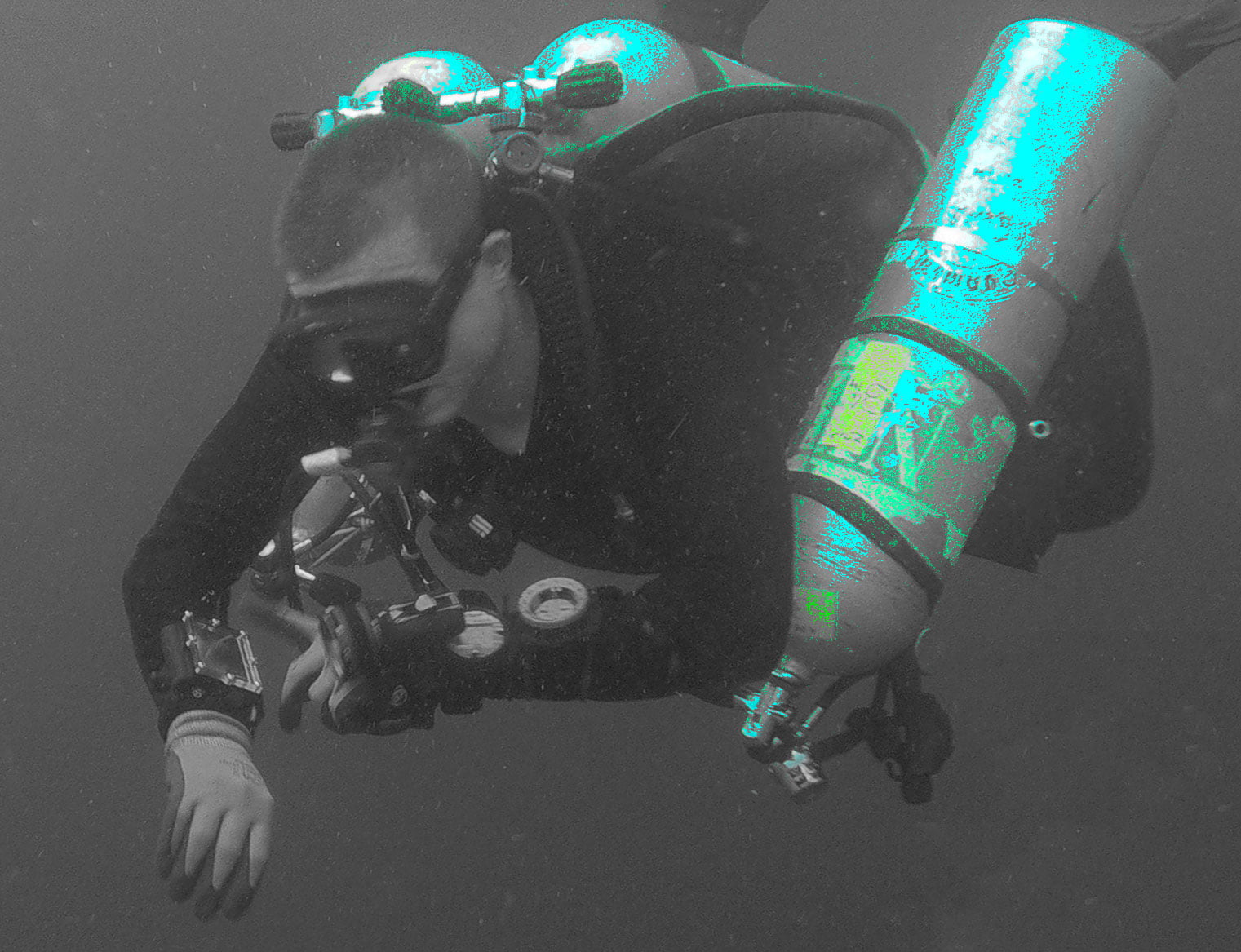
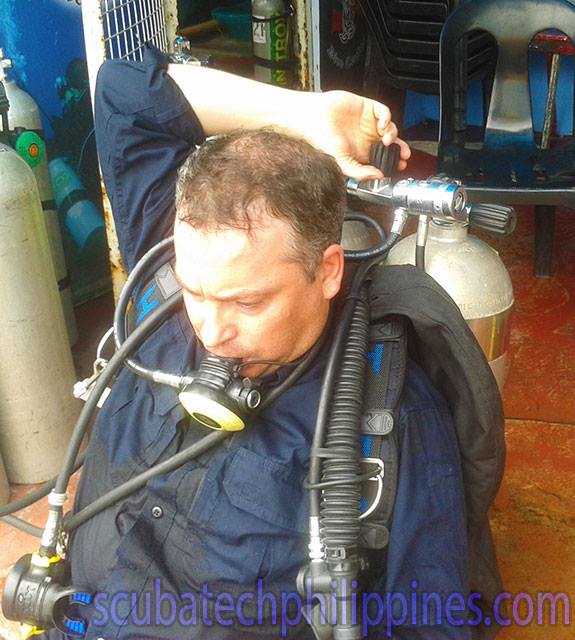
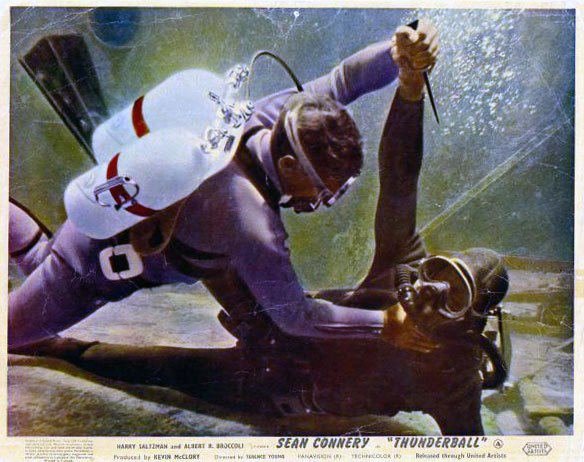
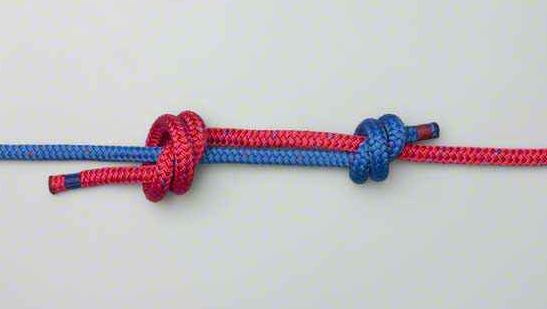

Andy, i know, that this article is old, but anyway:
* 70/85 – “Slow tissue inert-gas loading has been minimized” – is not true, by lowering the gradient, you only tolerate higher tissue stress, but the loading is the same, it is defined by the model.
* Super saturation factors picture: It clearly show dramatical difference between the tissue stress in higher depths, sure it converges to similar values at low depths. But that is meaning of GFLow – to reduce the stress at depth.
* I would like to see the tissues stress from the dive you show with the example gradients. If the runtime is similar, than the only difference is the tissue stress.